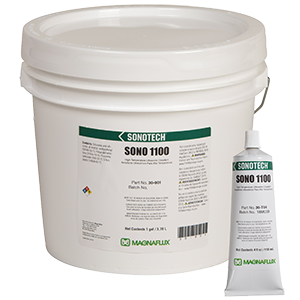Sono 1100 provides coupling for high-temperature thickness gauging and will maintain acoustic coupling at high temperatures beyond 15 secs. to give ample time to obtain thickness readings. In most cases, the signal strength increases with time to the point of the couplant’s thermal decomposition. Recommended temperature range is 700 to 775°F / 371 to 413°C
Sono 1100 is available in the following sizes:

| Appearance: | Opaque paste |
| Color: | Beige |
| Viscosity: | Medium paste |
| Silicone: | Yes |
| Glycerin: | No |
| Propylene Glycol: | No |
| Water Soluble: | No |
| Halogens: | N/A |
| Sulfur: | N/A |
| Flash Point*: | 455°F (235°C) |
| Auto-Ignition Temperature†: | 862°F (461°C) |
| Temperature Range‡: | 700° to 775°F (371° to 413°C) |
| Storage Temperature: | 50° to 86°F (10° to 30°C) |
| Compatibility: | Most metals |
* Flash point temperature determined in accordance with ASTM Method D92 using the Cleveland Cup method. In areas where vapors may be confined in an enclosed or semi-enclosed area, the actual flash point of this product may be lower than recorded.
† Auto-Ignition temperature determined in accordance with ASTM Method E659.
‡ Recommended temperature based on Flash Point and Auto Ignition Temperature. In areas where flame or other ignition sources may be present, or in applications where vapors may be confined in an enclosed or semi-enclosed area, these products should not be used above the flash point temperature.
In most applications, the transducer is best coupled with the thinnest layer of couplant possible. Apply a small bead of couplant directly to the center of the transducer face and push the transducer down onto the test surface with a uniform force so the couplant spreads out evenly towards the edge of the transducer.
For best results, allow a few seconds of “melttime” before taking temperature reading. Signal attenuation may occur if this couplant is used at a temperature below the recommended operating range. In high-temperature applications it is recommended that extra care is taken to use just enough couplant to perform the test procedure as excess couplant may increase vapors which can pose a flash hazard.
Remove excess couplant from transducers and other surfaces by wiping with disposable rags or paper towels, being careful to protect skin from hot surfaces. Do not use solvent-based cleaners on hot surfaces.
Store couplant in the original container. Do not freeze. Store out of direct sunlight. Keep container closed when not in use. Never put unused couplant back into the original storage container.
Note: The 30-6XT04, case of six (6) 4 oz. tubes have been discontinued. The replacement is the 30-6XT05, case of six (6) 2.8 oz. tubes.
30-T04 individual 4 oz. tubes have been discontinued. The replacement is the 30-T05 individual 2.8 oz. tubes.
Minimum Order Size: Six (6) 2.8 oz. Tubes